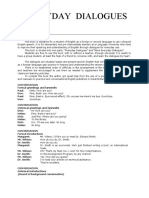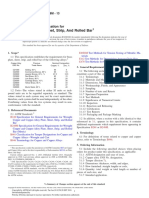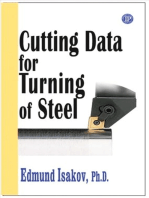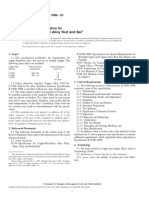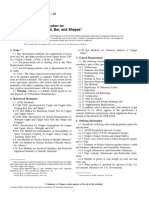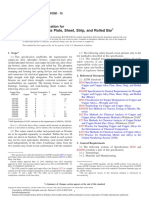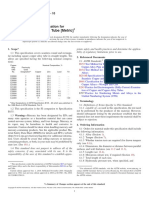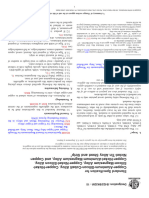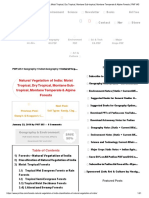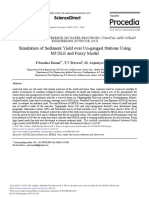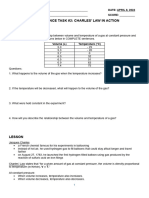0 ratings0% found this document useful (0 votes)
22 viewsPDFsam - B 360 - 15
PDFsam - B 360 - 15
Uploaded by
mike.jensen0581Copyright:
© All Rights Reserved
Available Formats
Download as PDF, TXT or read online from Scribd
PDFsam - B 360 - 15
PDFsam - B 360 - 15
Uploaded by
mike.jensen05810 ratings0% found this document useful (0 votes)
22 views5 pagesOriginal Title
PDFsam_B 360 - 15
Copyright
© © All Rights Reserved
Available Formats
PDF, TXT or read online from Scribd
Share this document
Did you find this document useful?
Is this content inappropriate?
Copyright:
© All Rights Reserved
Available Formats
Download as PDF, TXT or read online from Scribd
Download as pdf or txt
0 ratings0% found this document useful (0 votes)
22 views5 pagesPDFsam - B 360 - 15
PDFsam - B 360 - 15
Uploaded by
mike.jensen0581Copyright:
© All Rights Reserved
Available Formats
Download as PDF, TXT or read online from Scribd
Download as pdf or txt
You are on page 1of 5
Designation: B360 − 15
Standard Specification for
Hard-Drawn Copper Capillary Tube for Restrictor
Applications1
This standard is issued under the fixed designation B360; the number immediately following the designation indicates the year of
original adoption or, in the case of revision, the year of last revision. A number in parentheses indicates the year of last reapproval. A
superscript epsilon (´) indicates an editorial change since the last revision or reapproval.
1. Scope* E62 Test Methods for Chemical Analysis of Copper and
1.1 This specification establishes the requirements for hard- Copper Alloys (Photometric Methods) (Withdrawn 2010)3
drawn, seamless capillary tube made from Copper Alloy UNS E255 Practice for Sampling Copper and Copper Alloys for
Nos. C10800, C12000, or C12200. the Determination of Chemical Composition
2.2 ASHRAE Standard:
1.2 This tube is commonly supplied in straight lengths
No. 28 Method for Testing Capillary Tubes4
intended for restrictor applications such as metering lines for
liquids and gases where close control over smoothness and 3. General Requirements
diameter of the bore is required to insure uniform flow
characteristics between tubes. 3.1 The following sections of Specification B251 are a part
of this specification.
1.3 Units—The values stated in inch pound units are to be 3.1.1 Terminology,
regarded as standard. The values given in parentheses are 3.1.2 Workmanship, Finish and Appearance,
mathematical conversions to SI units that are provided for 3.1.3 Significance of Numerical Limits,
information only and are not considered standard. 3.1.4 Inspection,
1.4 This standard does not purport to address all of the 3.1.5 Rejection and Rehearing,
safety concerns, if any, associated with its use. It is the 3.1.6 Certification,
responsibility of the user of this standard to establish appro- 3.1.7 Test Reports, and
priate safety and health practices and determine the applica- 3.1.8 Package and Package Marking.
bility of regulatory limitations prior to use. 3.2 In addition, when a section with a title identical with
2. Referenced Documents those referenced in 3.1, above, appears in this specification, it
contains additional requirements which supplement those ap-
2.1 ASTM Standards:2 pearing in Specification B251.
B251 Specification for General Requirements for Wrought
Seamless Copper and Copper-Alloy Tube 4. Terminology
B577 Test Methods for Detection of Cuprous Oxide (Hydro-
4.1 For the definitions of terms related to copper and copper
gen Embrittlement Susceptibility) in Copper
alloys, refer to Terminology B846.
B601 Classification for Temper Designations for Copper and
Copper Alloys—Wrought and Cast 5. Ordering Information
B846 Terminology for Copper and Copper Alloys
E8/E8M Test Methods for Tension Testing of Metallic Ma- 5.1 The contract or purchase order for product under this
terials specification shall include the following information, as appli-
E53 Test Method for Determination of Copper in Unalloyed cable:
Copper by Gravimetry 5.1.1 ASTM designation and year of issue (for example,
B360 – XX),
5.1.2 Copper Alloy UNS No. (for example, C10800, Section
1
This specification is under the jurisdiction of ASTM Committee B05 on Copper 7, and Table 1),
and Copper Alloys and is the direct responsibility of Subcommittee B05.04 on Pipe
and Tube.
5.1.3 Dimensions: inside and outside diameter (Table 2),
Current edition approved July 1, 2015. Published July 2015. Originally approved
in 1960. Last previous edition approved in 2009 as B360 – 09. DOI: 10.1520/
3
B0360-15. The last approved version of this historical standard is referenced on
2
For referenced ASTM standards, visit the ASTM website, www.astm.org, or www.astm.org.
4
contact ASTM Customer Service at service@astm.org. For Annual Book of ASTM Available from American Society of Heating, Refrigerating, and Air-
Standards volume information, refer to the standard’s Document Summary page on Conditioning Engineers, Inc. (ASHRAE), 1791 Tullie Circle, NE, Atlanta, GA
the ASTM website. 30329, http://www.ashrae.org.
*A Summary of Changes section appears at the end of this standard
Copyright © ASTM International, 100 Barr Harbor Drive, PO Box C700, West Conshohocken, PA 19428-2959. United States
1
B360 − 15
TABLE 1 Chemical Requirements 7.2 These composition limits do not preclude the presence
Element, Percent C10800 C12000 C12200 of other elements. By agreement between the manufacturer and
Copper 99.95A 99.90B 99.9B purchaser, limits may be established and analysis required for
Phosphorus 0.005–0.012 0.004–0.012 0.015–0.040 un-named elements.
A
Copper + Silver + Phosphorus.
B
Silver is counted as Copper. 8. Temper
8.1 The tubes shall be furnished in the H805 (hard drawn)
condition.
5.1.4 Air Flow requirements (ft3/min or cfm), (see 10.3), if 9. Mechanical Property Requirements
required. 9.1 Tensile Strength:
NOTE 1—Product is specified to air flow requirements for capillary 9.1.1 The tubes shall have a tensile strength of 45 ksi (310
applications. MPa) minimum.
5.1.5 Quantity, total length, number of pieces or total weight
of each size, 10. Other Requirements
5.1.6 Length per piece of each size, and 10.1 Embrittlement Requirement:
5.2 The following options are available and should be 10.1.1 Samples of product produced from Coppers UNS
specified in the contract or purchase order when required: Nos. C10800 and C12000 shall be capable of passing the
5.2.1 Heat Identification or traceability details, embrittlement test of Procedure B of Test Methods B577. The
5.2.2 Embrittlement test, (see 10.1), actual performance of this test is not mandatory under the
5.2.3 Certification, (see 3.1.6), and terms of this specification unless specified in the ordering
5.2.4 Mill test report (see 3.1.7). information. In case of a dispute, a referee method in accor-
dance with Procedure C shall be employed.
6. Material and Manufacture 10.2 Cleanness Requirement:
6.1 Material: 10.2.1 The residue attributable to the tubes shall not exceed
6.1.1 The material of manufacture shall be from a cast and 0.0002 g/in.2 (0.310 g/m2) of internal surface of the tube when
extruded tube of Copper Alloy UNS No. C10800 (oxygen free, subjected to test as directed in 16.4 (Refer to Table 2)
low phosphorus), C12000 (phosphorus deoxidized, low re- 10.3 Air Flow Requirement:
sidual phosphorus), or C12200 (phosphorus deoxidized, high 10.3.1 When specified, the tubes shall conform to the air
residual phosphorus) of such purity and soundness as to be flow requirements, in ft3/min [cfm] stipulated at the time of
suitable for processing in to the product prescribed herein. order placement, when tested in accordance with the test in
6.1.2 In the event heat identification or traceability is 16.5.
required, the purchaser shall specify the details desired.
NOTE 2—Due to the discontinuous nature of processing castings into 11. Dimensions, Mass, and Permissible Variations
wrought products, it is not always practical to identify a specific casting 11.1 Outside Diameter Tolerance:
analysis with a specific quantity of finished material. 11.1.1 The average outside diameter tolerance shall be
6.2 Manufacture: 60.002 in. (0.051 mm).
6.2.1 The product shall be manufactured by cold drawing 11.2 Inside Diameter Tolerance:
processes as to produce a uniform wrought structure in the 11.2.1 The average inside diameter tolerance shall be
finished product. 60.001 in. (0.025 mm) which shall be determined by pin
6.2.2 The tube shall be finished by degreasing or other gages, or when specified, by the air flow test. The flow rate
cleaning operations to meet the stringent requirements for tolerance will be agreed upon by the purchaser and manufac-
cleanness of the inner diameter. turer.
6.2.3 The outside and inside of both ends of straight lengths
shall be made free of burrs that could restrict flow, by burr-free 11.3 Straightness:
cutting, brushing, or chamfering. 11.3.1 The straightness tolerance shall be in accordance
6.2.4 The maximum allowable residue as determined by the with Table 3.
cleanness test described in 16.4 shall not exceed the value
given in Table 2 for the tube size tested. 12. Workmanship, Finish, and Appearance
12.1 The product shall be free of defects, but blemishes of
7. Chemical Composition a nature that do not interfere with the intended application are
7.1 The material shall conform to the chemical composition acceptable.
requirements in Table 1 for the Copper UNS Alloy No. 12.2 The inside and outside edges of both ends of straight
designation specified in the ordering information. lengths of tube shall be free of burrs (see 6.2.3).
7.1.1 Results of analysis on a product (check) sample shall
conform to the composition requirements within the permitted
5
analytical variance specified in Table 1. Refer to Classification B601 for definition of temper designations.
2
B360 − 15
TABLE 2 Standard Dimensions and Residue Limits of Interior Surfaces for Capillary Tubes
Maximum Allowable
Inside Diameter, Mean Wall Thickness, Cross-Sectional Area of
Outside Diameter, in. (mm) Weight, lb/ft (kg/m) Residue,
in. (mm) in. (mm) Tube Bore, in.2 (mm2)A
g/linear ft (g/linear m)
0.072 (1.83) 0.026 (0.660) 0.023 (0.584) 0.0005309 (0.343) 0.01373 (0.0204) 0.00020 (0.000656)
0.072 (1.83) 0.028 (0.711) 0.022 (0.558) 0.0006158 (0.397) 0.01340 (0.0199) 0.00021 (0.000689)
0.081 (2.06) 0.031 (0.787) 0.025 (0.635) 0.0007548 (0.487) 0.01705 (0.0254) 0.00023 (0.000754)
0.081 (2.06) 0.033 (0.838) 0.024 (0.606) 0.0008553 (0.552) 0.01666 (0.0248) 0.00025 (0.000820)
0.087 (2.21) 0.036 (0.914) 0.0255 (0.648) 0.001018 (0.657) 0.01910 (0.0284) 0.00027 (0.000886)
0.087 (2.21) 0.039 (0.991) 0.024 (0.606) 0.001195 (0.771) 0.01842 (0.0239) 0.00029 (0.000951)
0.093 (2.36) 0.042 (1.07) 0.0255 (0.648) 0.001385 (0.893) 0.02096 (0.0312) 0.00032 (0.00105)
0.097 (2.47) 0.046 (1.17) 0.025 (0.648) 0.001662 (1.07) 0.02221 (0.0331) 0.00035 (0.00115)
0.099 (2.51) 0.049 (1.24) 0.025 (0.635) 0.001886 (1.22) 0.02253 (0.0335) 0.00037 (0.00121)
0.106 (2.69) 0.054 (1.37) 0.026 (0.660) 0.002290 (1.48) 0.02533 (0.0377) 0.00041 (0.00134)
0.112 (2.84) 0.059 (1.50) 0.0265 (0.673) 0.002734 (1.76) 0.02760 (0.0411) 0.00044 (0.00144)
0.125 (3.18) 0.064 (1.63) 0.0305 (0.775) 0.003217 (2.07) 0.03511 (0.0522) 0.00048 (0.00157)
0.125 (3.18) 0.070 (1.78) 0.0275 (0.698) 0.003848 (2.48) 0.03266 (0.0486) 0.00053 (0.00174)
0.125 (3.18) 0.075 (1.91) 0.025 (0.635) 0.004418 (2.85) 0.03054 (0.0454) 0.00057 (0.00187)
0.145 (3.68) 0.080 (2.03) 0.0325 (0.826) 0.005027 (3.24) 0.04453 (0.0663) 0.00060 (0.00197)
0.145 (3.68) 0.085 (2.16) 0.030 (0.762) 0.005674 (3.66) 0.04202 (0.0625) 0.00064 (0.00210)
0.145 (3.68) 0.090 (2.29) 0.0275 (0.698) 0.006362 (4.10) 0.03936 (0.0586) 0.00068 (0.00223)
0.160 (4.06) 0.100 (2.54) 0.030 (0.762) 0.007854 (5.07) 0.04750 (0.0707) 0.00075 (0.00246)
0.160 (4.06) 0.110 (2.79) 0.025 (0.635) 0.009503 (6.13) 0.04111 (0.0611) 0.00083 (0.00272)
0.188 (4.78) 0.120 (3.03) 0.034 (0.864) 0.01131 (7.29) 0.06377 (0.0949) 0.00090 (0.00295)
0.188 (4.78) 0.130 (3.30) 0.029 (0.737) 0.01327 (8.56) 0.05616 (0.0836) 0.00098 (0.00321)
0.200 (5.08) 0.145 (3.68) 0.0275 (0.698) 0.01651 (10.7) 0.05779 (0.0860) 0.00109 (0.00358)
0.220 (5.59) 0.160 (4.06) 0.030 (0.762) 0.02011 (13.0) 0.06943 (0.103) 0.00121 (0.00397)
0.240 (6.10) 0.175 (4.45) 0.0325 (0.826) 0.02405 (15.5) 0.08107 (0.121) 0.00132 (0.00433)
A
Cross-section area of tube bore in.2 = (π)(ID)2/4 where: π = 3.1416 and ID = inside diameter.
TABLE 3 Straightness Tolerance 13.2.3.1 When samples are taken at the time the castings are
Length Maximum Curvature (Depth of Arc) poured, at least one sample shall be taken for each group of
ft (m) in. (mm)
castings poured simultaneously from the same source of
Over 3 (0.914) to 6 (1.83), incl. .188 in. (4.8)
Over 6 (1.83) to 8 (2.44), incl. .313 in. (7.9)
molten metal.
Over 8 (2.44) to 10 (3.05), incl. .500 in. (13) 13.2.3.2 When samples are taken from the semi-finished
Over 10 (3.05) .500 in. (13) in any 10 ft (3.05 m) section
product, a sample shall be taken to represent each 10 000 lb
(4537 kg) or fraction thereof, except that not more than one
sample per piece shall be required.
13.3 Other Tests:
13. Sampling 13.3.1 Specimens for all other tests shall be taken from two
13.1 The lot size, portion size, and selection of pieces shall of the sample pieces taken in 13.1.2.
be as follows:
13.1.1 Lot Size—1000 pieces, or maximum of 100 lb, or 14. Number of Tests and Retests
fraction thereof. 14.1 Tests:
13.1.2 Portion Size—0.2 % of the pieces in the lot, or a 14.1.1 Chemical Analysis—Chemical composition shall be
minimum of four pieces, whichever is greater. determined as the per element mean of results from at least two
13.2 Chemical Composition: replicate analyses of the sample and each determination must
13.2.1 The sample shall be taken in approximately equal meet the specification requirements.
weight from each portion piece selected in 13.1.2 and prepared 14.1.2 Tensile Strength—Shall be reported as the average
in accordance with Practice E255. The minimum weight of the results obtained from the specimen prepared from each of two
composite sample shall be 150 g. pieces selected in 13.1.2.
13.2.2 Instead of sampling in accordance with Practice 14.1.3 Specimens for all other tests must conform to speci-
E255, the manufacturer shall have the option of sampling at the fication requirements.
time castings are poured or taken from the semi-finished
product. When the chemical composition has been determined 14.2 Retests:
during the course of manufacture, sampling of the finished 14.2.1 When requested by the manufacturer or supplier, a
product is not required. retest shall be permitted when results of tests obtained by the
13.2.3 The number of samples taken during the course of purchaser fail to conform to the requirements of the product
manufacture shall be as follows: specification.
3
B360 − 15
14.2.2 The retest shall be as directed in the product speci- 16.2.1 Tensile strength shall be determined as directed in
fication for the initial test, except for the number of test procedure for small tube in Test Methods E8/E8M.
specimens which shall be twice that normally required for the 16.2.2 Test results are not seriously affected by variations in
specified test. speed of testing. A considerable range of testing speed is
14.2.3 All test specimens shall conform to the product permitted; however, the rate of stressing to the yield strength
specification requirement(s) in retest. Failure to comply shall should not exceed 100 ksi (690 MPa)/min. Above the yield
be cause for rejection. strength the movement per minute of the testing machine head
under load should not exceed 0.5 in./in. (0.5 mm/mm) of gage
15. Specimen Preparation length (or distance between grips for full section specimens).
15.1 Chemical Analysis: 16.3 Embrittlement:
15.1.1 Preparation of the analytical specimens shall be the 16.3.1 Procedure B of Test Method B577 shall be followed
responsibility of the reporting laboratory. and in the case of dispute Procedure C shall be followed.
15.2 Tensile Strength: 16.4 Cleanness:
15.2.1 The test specimen shall be of the full section of the 16.4.1 In performing this test care must be exercised to
tube and shall conform to the requirements specified in the clean the outside surface of the end of the specimen to be
section “Specimens for Pipe and Tube” in Test Methods immersed in the solvent. Full-length specimens of finished
E8/E8M. product should be tested to minimize the possibility of con-
tamination from cutting operations. If full-length specimens
15.3 Embrittlement: can not be utilized the specimens must be prepared in such a
15.3.1 Test specimens shall be prepared in accordance with manner as to prevent the inclusion in the residue of copper
Procedure B of Test Methods B577. In case of dispute, test chips or dust, resulting from specimen preparations.
specimens preparation shall be in accordance with Procedure C 16.4.2 Using the schematic depicted in Fig. 1, clean the
of Test Methods B577. interior surface of the sample with a suitable solvent (not less
15.4 Cleanness: than 50 mL per specimen).
15.4.1 Full-length specimens of finished product, subse- 16.4.3 After collection of the solvent and residue in the
quent to cleaning, shall be selected for testing, where feasible, vacuum flask transfer the contents of the vacuum flask to a
to minimize the possibility of contamination from cutting beaker of known weight. Transfer an equivalent amount of
operations. clean solvent into a second beaker of known weight. (This is a
15.4.2 If full-length specimens can not be utilized due to blank to determine the contaminates in the solvent.)
size, length, or other constraints, the specimen must be 16.4.4 With adequate exhaust, evaporate the solvent in both
prepared in such a manner as to prevent the inclusion in the beakers to near dryness on a low temperature hot plate or
residue of copper chips or dust, resulting from cutting opera- sandbath. (Warning—Overheating may cause charring of the
tions. residue.)
15.4.3 In performing this test, care must be exercised to 16.4.5 Place the beakers in a drying oven set at 105 6 5°C
clean the outside surface of the end of the specimen to be for approximately 10 min, or longer as necessary, to complete
immersed in the solvent. the drying process. Remove the dried containers, cool in a
desiccator, and weigh.
15.5 Air Flow Test: 16.4.6 Calculate the weight gain of the beakers by subtract-
15.5.1 Full-length specimens of finished product shall be ing the original weight from the final weight for each.
selected for testing.
~ Final Weight 2 Original Weight 5 Residue Weight!
16. Test Methods
16.1 Chemical Analysis:
16.1.1 In cases of disagreement, test methods for chemical
analysis shall be subject to agreement between the manufac-
turer or supplier and the purchaser. The following table is a list
of published methods, some of which may no longer be viable,
which along with others not listed, may be used subject to
agreement:
Element Test Method
Copper E53
Phosphorus E62
16.1.2 Test methods to be followed for the determination of
elements resulting from contractual or purchase order agree-
ment shall be as agreed upon between the manufacturer or
supplier and the purchaser.
16.2 Tensile Strength: FIG. 1 Residue Extraction Apparatus
4
B360 − 15
16.4.7 The residue per unit area is then calculated using the 17. Packaging and Package Marking
following formula:
17.1 The tube ends shall be protected in such a manner as to
~ Residue Weight of Sample 2 Residue Weight of Blank! prevent entrance of dust, chips or other foreign matter.
Interior Surface Area of Sample ~ in. 2 !
16.5 Air Flow: 18. Keywords
16.5.1 Airflow shall be determined in accordance with
18.1 C10800; C12000; C12200; capillary tube; metering
ASHRAE Standard 28 (Current Edition) after the bore has
tube; restrictor tube; tube
been washed with a suitable solvent.
16.5.2 The manufacturer and the purchaser shall agree upon
the test method used for manufacturing quality control.
SUMMARY OF CHANGES
Committee B05 has identified the principal changes to this specification that have been incorporated since the
2009 issue as follows:
(1) 2.1 Referenced Documents, E8 is now combined document (4) 12.2, wrong paragraph # referenced. 6.2.2 should be 6.2.3.
E8/E8M. This same change was also made in 15.2.1 and (5) 14.1.1, Typo – analysis should be analyses.
16.2.1. (6) 14.1.3, Typo – test should be tests.
(2) 2.1 Referenced Documents, removed reference to B950 (7) 16.1, 16.1.1, and 16.1.2 – Changed wording to reflect
since Form of Product Spec. changes were performed for standard wording from B950 Guide for Editorial Procedures
previous edition. and Form of Product Specifications for Copper and Copper
(3) Table 2 Footnote A, changed “Pi” to π symbol to be Alloys.
consistent within sentence.
ASTM International takes no position respecting the validity of any patent rights asserted in connection with any item mentioned
in this standard. Users of this standard are expressly advised that determination of the validity of any such patent rights, and the risk
of infringement of such rights, are entirely their own responsibility.
This standard is subject to revision at any time by the responsible technical committee and must be reviewed every five years and
if not revised, either reapproved or withdrawn. Your comments are invited either for revision of this standard or for additional standards
and should be addressed to ASTM International Headquarters. Your comments will receive careful consideration at a meeting of the
responsible technical committee, which you may attend. If you feel that your comments have not received a fair hearing you should
make your views known to the ASTM Committee on Standards, at the address shown below.
This standard is copyrighted by ASTM International, 100 Barr Harbor Drive, PO Box C700, West Conshohocken, PA 19428-2959,
United States. Individual reprints (single or multiple copies) of this standard may be obtained by contacting ASTM at the above
address or at 610-832-9585 (phone), 610-832-9555 (fax), or service@astm.org (e-mail); or through the ASTM website
(www.astm.org). Permission rights to photocopy the standard may also be secured from the Copyright Clearance Center, 222
Rosewood Drive, Danvers, MA 01923, Tel: (978) 646-2600; http://www.copyright.com/
5
You might also like
- B49-20 Copper RodDocument8 pagesB49-20 Copper RodAmit Mishra100% (1)
- Astm B88 2020Document8 pagesAstm B88 2020SKY00SNOWNo ratings yet
- Computer Programming Diagnostic TestDocument2 pagesComputer Programming Diagnostic TestShanin Estavillo100% (2)
- Astm B16-B16M-05Document5 pagesAstm B16-B16M-05reza acbariNo ratings yet
- Economics+3 04+Making+a+Budget+and+Savings+PlanDocument6 pagesEconomics+3 04+Making+a+Budget+and+Savings+Plansylvia seletoNo ratings yet
- Astm B206Document4 pagesAstm B206BhanuNo ratings yet
- Naval Brass Rod, Bar, and Shapes: Standard Specification ForDocument8 pagesNaval Brass Rod, Bar, and Shapes: Standard Specification Foranurag yadavNo ratings yet
- Free-Cutting Brass Rod, Bar and Shapes For Use in Screw MachinesDocument5 pagesFree-Cutting Brass Rod, Bar and Shapes For Use in Screw Machinesanurag yadavNo ratings yet
- Everyday DialoguesDocument109 pagesEveryday DialoguesZulfiyya Yusifova100% (4)
- Brass Plate, Sheet, Strip, and Rolled Bar: Standard Specification ForDocument9 pagesBrass Plate, Sheet, Strip, and Rolled Bar: Standard Specification ForarunjacobnNo ratings yet
- Bronze Castings For Bridges and TurntablesDocument5 pagesBronze Castings For Bridges and Turntablesnicu1212No ratings yet
- B49 15 PDFDocument8 pagesB49 15 PDFUniversal LaboratoryNo ratings yet
- Astm B16 PDFDocument5 pagesAstm B16 PDFpilo111100% (3)
- ASTM B68 68A-Copper Full Hard Pipe STD PDFDocument12 pagesASTM B68 68A-Copper Full Hard Pipe STD PDFAsha ValandNo ratings yet
- Double Skin Facade PDFDocument252 pagesDouble Skin Facade PDFRifkyKurniansyah100% (6)
- ASTM B466 (2009) - Standard Specification For Seamless Copper-Nickel Pipe and TubeDocument6 pagesASTM B466 (2009) - Standard Specification For Seamless Copper-Nickel Pipe and Tubeanoop100% (1)
- Copper-Nickel-Tin Spinodal Alloy Strip: Standard Specification ForDocument6 pagesCopper-Nickel-Tin Spinodal Alloy Strip: Standard Specification ForDanZel DanNo ratings yet
- Astm B16-10Document5 pagesAstm B16-10Francisco Villasmil OlivaresNo ratings yet
- PDFsam - B 42 - 15aDocument7 pagesPDFsam - B 42 - 15amike.jensen0581No ratings yet
- Seamless Brass Tube: Standard Specification ForDocument6 pagesSeamless Brass Tube: Standard Specification FormahfuzNo ratings yet
- Seamless Copper Pipe, Standard SizesDocument7 pagesSeamless Copper Pipe, Standard SizesAhmed BilalNo ratings yet
- Copper-Beryllium Alloy Rod and Bar: Standard Specification ForDocument5 pagesCopper-Beryllium Alloy Rod and Bar: Standard Specification ForJyothishNo ratings yet
- Brass Plate, Sheet, Strip, and Rolled Bar: Standard Specification ForDocument9 pagesBrass Plate, Sheet, Strip, and Rolled Bar: Standard Specification Forgfrankie007No ratings yet
- Contentcode 2Document9 pagesContentcode 2BaronNo ratings yet
- PDFsam - B 379 - 11Document5 pagesPDFsam - B 379 - 11mike.jensen0581No ratings yet
- Wrought Copper-Alloy Bearing and Expansion Plates and Sheets For Bridge and Other Structural UseDocument5 pagesWrought Copper-Alloy Bearing and Expansion Plates and Sheets For Bridge and Other Structural UseAnurag YadavNo ratings yet
- Astm B16 2010Document5 pagesAstm B16 2010brunobassottiNo ratings yet
- ASTM-B49-17Document4 pagesASTM-B49-17Hamza Ali Abasi AliNo ratings yet
- B196B196M-07 (Reapproved 2013) E1Document5 pagesB196B196M-07 (Reapproved 2013) E1Mohamad ZandiNo ratings yet
- Seamless Red Brass Pipe, Standard SizesDocument7 pagesSeamless Red Brass Pipe, Standard SizesPushkar GopalNo ratings yet
- Phosphor Bronze Wire: Standard Specification ForDocument3 pagesPhosphor Bronze Wire: Standard Specification Forbenedick barquinNo ratings yet
- Copper-Zinc-Aluminum-Cobalt Alloy, Copper-Zinc-Tin-Iron Alloy Plate, Sheet, Strip, and Rolled BarDocument5 pagesCopper-Zinc-Aluminum-Cobalt Alloy, Copper-Zinc-Tin-Iron Alloy Plate, Sheet, Strip, and Rolled Barruben castroNo ratings yet
- Copper-Beryllium Alloy Plate, Sheet, Strip, and Rolled Bar: Standard Specification ForDocument11 pagesCopper-Beryllium Alloy Plate, Sheet, Strip, and Rolled Bar: Standard Specification ForMohamad ZandiNo ratings yet
- Astm B196 B196M 01Document2 pagesAstm B196 B196M 01moktar albhlolyNo ratings yet
- ASTM B 75 2011 - STD Spec For Seamless Copper TubeDocument8 pagesASTM B 75 2011 - STD Spec For Seamless Copper TubenVent QualityNo ratings yet
- Astm B88Document7 pagesAstm B88k.boukhariNo ratings yet
- B455Document3 pagesB455basha100% (1)
- B43 14 PDFDocument7 pagesB43 14 PDFUniversal LaboratoryNo ratings yet
- B197B197M-07 (Reapproved 2013)Document6 pagesB197B197M-07 (Reapproved 2013)AtlanticNo ratings yet
- Steam or Valve Bronze Castings: Standard Specification ForDocument3 pagesSteam or Valve Bronze Castings: Standard Specification ForPushkar GopalNo ratings yet
- ASTM B 466-14Document6 pagesASTM B 466-14juan.rodriguez-No ratings yet
- Copper Rod For Electrical PurposesDocument3 pagesCopper Rod For Electrical PurposesRamdas PaithankarNo ratings yet
- ASTM B121 Leaded Brass Sheet PlateDocument4 pagesASTM B121 Leaded Brass Sheet Platestrip1100% (2)
- Copper-Zinc-Tin-Bismuth Alloy Rod, Bar and Wire: Standard Specification ForDocument5 pagesCopper-Zinc-Tin-Bismuth Alloy Rod, Bar and Wire: Standard Specification ForErick VargasNo ratings yet
- Seamless Copper Water Tube (Metric) : Standard Specification ForDocument7 pagesSeamless Copper Water Tube (Metric) : Standard Specification ForEslam ElsayedNo ratings yet
- B16 - B16M 10 (Reapproved 2015)Document5 pagesB16 - B16M 10 (Reapproved 2015)orlando acevedoNo ratings yet
- Copper Rod For Electrical PurposesDocument8 pagesCopper Rod For Electrical PurposesAhmed BilalNo ratings yet
- PDFsam - B 441 - 16Document4 pagesPDFsam - B 441 - 16mike.jensen0581No ratings yet
- Aluminum Bronze Sheet, Strip, and Rolled Bar: Standard Specification ForDocument4 pagesAluminum Bronze Sheet, Strip, and Rolled Bar: Standard Specification Forbenedick barquinNo ratings yet
- Copper-Beryllium Alloy Rod and Bar: Standard Specification ForDocument5 pagesCopper-Beryllium Alloy Rod and Bar: Standard Specification ForAyvid HgnisNo ratings yet
- B206B206M 12Document4 pagesB206B206M 12Mohamad ZandiNo ratings yet
- Free-Cutting Brass Rod, Bar and Shapes For Use in Screw MachinesDocument5 pagesFree-Cutting Brass Rod, Bar and Shapes For Use in Screw Machinesjavier perezNo ratings yet
- PDFsam - B 455 - 10Document3 pagesPDFsam - B 455 - 10mike.jensen0581No ratings yet
- Naval Brass Rod, Bar, and Shapes: Standard Specification ForDocument7 pagesNaval Brass Rod, Bar, and Shapes: Standard Specification ForHoang Duy PhuongNo ratings yet
- Naval Brass Rod, Bar, and Shapes: Standard Specification ForDocument7 pagesNaval Brass Rod, Bar, and Shapes: Standard Specification Formanuel floresNo ratings yet
- ASTM B169 - 10 Aluminium Bronze Sheet Strip and Rolled BarDocument4 pagesASTM B169 - 10 Aluminium Bronze Sheet Strip and Rolled BarPacco HmNo ratings yet
- B 121 - B 121M - 95 Qjeyms05nqDocument3 pagesB 121 - B 121M - 95 Qjeyms05nqchavezleslyaliNo ratings yet
- Astm B75 02Document3 pagesAstm B75 02khan shahrukhNo ratings yet
- ASTM B103/B103M 15: Standard Speci Cation For Phosphor Bronze Plate, Sheet, Strip, and Rolled BarDocument7 pagesASTM B103/B103M 15: Standard Speci Cation For Phosphor Bronze Plate, Sheet, Strip, and Rolled BarElias Arenas PanccaNo ratings yet
- B 99 - B 99M - 01 Qjk5l0i5ou0Document3 pagesB 99 - B 99M - 01 Qjk5l0i5ou0chavezleslyaliNo ratings yet
- B870 21 2 01 Standard Specification For Copper Beryllium Alloy ForgingsDocument3 pagesB870 21 2 01 Standard Specification For Copper Beryllium Alloy ForgingsShodji MabungaNo ratings yet
- B135M-10 Standard Specification For Seamless Brass Tube (Metric)Document6 pagesB135M-10 Standard Specification For Seamless Brass Tube (Metric)Salma FarooqNo ratings yet
- Non-Destructive Evaluation of Corrosion and Corrosion-assisted CrackingFrom EverandNon-Destructive Evaluation of Corrosion and Corrosion-assisted CrackingRaman SinghNo ratings yet
- All About History 59 - 2017 UK - 51Document10 pagesAll About History 59 - 2017 UK - 51mike.jensen0581No ratings yet
- All About History 59 - 2017 UK - 21Document20 pagesAll About History 59 - 2017 UK - 21mike.jensen0581No ratings yet
- History 59 UK 1Document20 pagesHistory 59 UK 1mike.jensen0581No ratings yet
- All About History 59 - 2017 UK - 41Document10 pagesAll About History 59 - 2017 UK - 41mike.jensen0581No ratings yet
- All About History 59 - 2017 UK - 61Document10 pagesAll About History 59 - 2017 UK - 61mike.jensen0581No ratings yet
- PDFsam - B 446 - 03 (2014)Document5 pagesPDFsam - B 446 - 03 (2014)mike.jensen0581No ratings yet
- PDFsam - B 447 - 12aDocument10 pagesPDFsam - B 447 - 12amike.jensen0581No ratings yet
- PDFsam - B 417 - 13Document3 pagesPDFsam - B 417 - 13mike.jensen0581No ratings yet
- PDFsam - B 424 - 11 (2016)Document4 pagesPDFsam - B 424 - 11 (2016)mike.jensen0581No ratings yet
- PDFsam - B 403 - 12Document4 pagesPDFsam - B 403 - 12mike.jensen0581No ratings yet
- PDFsam - B 416 - 98 (2013)Document4 pagesPDFsam - B 416 - 98 (2013)mike.jensen0581No ratings yet
- PDFsam - B 401 - 12 (2016)Document5 pagesPDFsam - B 401 - 12 (2016)mike.jensen0581No ratings yet
- PDFsam - B 423 - 11 (2016)Document4 pagesPDFsam - B 423 - 11 (2016)mike.jensen0581No ratings yet
- PDFsam - B 386 - 03 (2011)Document5 pagesPDFsam - B 386 - 03 (2011)mike.jensen0581No ratings yet
- PDFsam - B 400 - B 400M - 14Document6 pagesPDFsam - B 400 - B 400M - 14mike.jensen0581No ratings yet
- PDFsam - B 422 - B 422M - 15Document5 pagesPDFsam - B 422 - B 422M - 15mike.jensen0581No ratings yet
- PDFsam - B 393 - 09e1Document6 pagesPDFsam - B 393 - 09e1mike.jensen0581No ratings yet
- PDFsam - B 368 - 09 (2014)Document4 pagesPDFsam - B 368 - 09 (2014)mike.jensen0581No ratings yet
- PDFsam - B 361 - 16Document5 pagesPDFsam - B 361 - 16mike.jensen0581No ratings yet
- PDFsam - B 390 - 92 (2006)Document4 pagesPDFsam - B 390 - 92 (2006)mike.jensen0581No ratings yet
- PDFsam - B 389 - 81 (2016)Document4 pagesPDFsam - B 389 - 81 (2016)mike.jensen0581No ratings yet
- PDFsam - B 380 - 97 (2013)Document3 pagesPDFsam - B 380 - 97 (2013)mike.jensen0581No ratings yet
- PDFsam - B 379 - 11Document5 pagesPDFsam - B 379 - 11mike.jensen0581No ratings yet
- PDFsam - B 374 - 06 (2011)Document10 pagesPDFsam - B 374 - 06 (2011)mike.jensen0581No ratings yet
- PDFsam - B 366 - B 366M - 16Document9 pagesPDFsam - B 366 - B 366M - 16mike.jensen0581No ratings yet
- PDFsam - B 367 - 13Document6 pagesPDFsam - B 367 - 13mike.jensen0581No ratings yet
- PDFsam - B 371 - B 371M - 15Document4 pagesPDFsam - B 371 - B 371M - 15mike.jensen0581No ratings yet
- PDFsam - B 363 - 14Document4 pagesPDFsam - B 363 - 14mike.jensen0581No ratings yet
- UntitledDocument4 pagesUntitledJeff GarnettNo ratings yet
- Notice of Vacancies (Calasiao) Up To June 04Document1 pageNotice of Vacancies (Calasiao) Up To June 04PRC BaguioNo ratings yet
- Sts Apc Thon-7gtpy6 r5 enDocument4 pagesSts Apc Thon-7gtpy6 r5 enCristian SevillaNo ratings yet
- Entrainment Calculation PDFDocument1 pageEntrainment Calculation PDFnirmal_subudhiNo ratings yet
- Highlighter - English-Spanish DictionaryDocument1 pageHighlighter - English-Spanish DictionaryMarta ChamorroNo ratings yet
- 1.Lidar-Based Cooperative SLAM With DifferentDocument6 pages1.Lidar-Based Cooperative SLAM With Differentrajmeet singhNo ratings yet
- Operations Manual: IM30AE Non-Directional Overcurrent RelayDocument16 pagesOperations Manual: IM30AE Non-Directional Overcurrent RelaycrcruzpNo ratings yet
- 6081HF001 - B John DeereDocument2 pages6081HF001 - B John DeereJosé MontillaNo ratings yet
- Spatial Analysis of Urban SquaresDocument26 pagesSpatial Analysis of Urban Squaresp jNo ratings yet
- Sps. Vicente Dionisio and Anita DionisioDocument1 pageSps. Vicente Dionisio and Anita DionisioDiane Dee YaneeNo ratings yet
- 2011 Cushman Titan 36v 2p Tech SpecDocument6 pages2011 Cushman Titan 36v 2p Tech SpecForklift Systems IncorporatedNo ratings yet
- TM 5-3810-300-24&P3Document736 pagesTM 5-3810-300-24&P3svaasandNo ratings yet
- Natural Vegetation of India - Moist Tropical, Dry Tropical, Montane Sub-Tropical, Montane Temperate & Alpine Forests - PMF IASDocument21 pagesNatural Vegetation of India - Moist Tropical, Dry Tropical, Montane Sub-Tropical, Montane Temperate & Alpine Forests - PMF IASsriramNo ratings yet
- Padasalai Net TNPSC Group 4 Maths Study MaterialDocument34 pagesPadasalai Net TNPSC Group 4 Maths Study MaterialMaithiliNo ratings yet
- Simulation of Sediment Yield Over Un-Gauged Stations Using MUSLE and Fuzzy ModelDocument8 pagesSimulation of Sediment Yield Over Un-Gauged Stations Using MUSLE and Fuzzy ModelDwirapi TirtoNo ratings yet
- Interfacing Arduino With Matlab (First Book 1) ADocument98 pagesInterfacing Arduino With Matlab (First Book 1) Aend31750No ratings yet
- Halley Vs PrintwellDocument4 pagesHalley Vs PrintwellAthena SantosNo ratings yet
- PR Unit 1 & 2Document28 pagesPR Unit 1 & 2meenal kaurNo ratings yet
- Canlubang Security Agency Corporation V NLRCDocument1 pageCanlubang Security Agency Corporation V NLRCMacNo ratings yet
- Van Valkenburgh V LutzDocument1 pageVan Valkenburgh V LutzMissPardisNo ratings yet
- RRLDocument10 pagesRRLCzarisse FermaNo ratings yet
- Place Value and Number Sense - Mathematics - 4th Grade by SlidesgoDocument53 pagesPlace Value and Number Sense - Mathematics - 4th Grade by Slidesgoadrianvibrianto28No ratings yet
- Kinevo 900Document22 pagesKinevo 900Eliana Caceres TorricoNo ratings yet
- Sonardyne 8070 71 WSMDocument2 pagesSonardyne 8070 71 WSMdahyar kiatmajaNo ratings yet
- PT 2 CHARLES LAW IN ACTION FinalDocument3 pagesPT 2 CHARLES LAW IN ACTION FinalhannahhannyyyNo ratings yet
- Lesson 10 Activity 1 2 3Document3 pagesLesson 10 Activity 1 2 3Maryalyn SutilNo ratings yet








